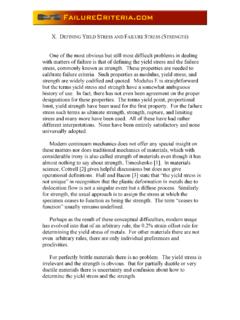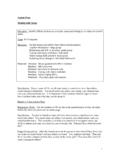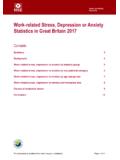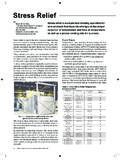Transcription of Defining Yield Stress and Failure Stress (Strength)
1 X. Defining Yield Stress AND Failure Stress ( strength ). One of the most obvious but still most difficult problems in dealing with matters of Failure is that of Defining the Yield Stress and the Failure Stress , commonly known as strength . These properties are needed to calibrate Failure criteria. Such properties as modulus, Yield Stress , and strength are widely codified and quoted. Modulus E is straightforward but the terms Yield Stress and strength have a somewhat ambiguous history of use. In fact, there has not even been agreement on the proper designations for these properties.
2 The terms Yield point, proportional limit, Yield strength have been used for the first property. For the Failure Stress such terms as ultimate strength , strength , rupture, and limiting Stress and many more have been used. All of these have had rather different interpretations. None have been entirely satisfactory and none universally adopted. Modern continuum mechanics does not offer any special insight on these matters nor does traditional mechanics of materials, which with considerable irony is also called strength of materials even though it has almost nothing to say about strength , Timoshenko [1].
3 In materials science, Cottrell [2] gives helpful discussions but does not give operational definitions. Hull and Bacon [3] state that the Yield Stress is not unique in recognition that the plastic deformation in metals due to dislocation flow is not a singular event but a diffuse process. Similarly for strength , the usual approach is to assign the Stress at which the specimen ceases to function as being the strength . The term ceases to function usually remains undefined. Perhaps as the result of these conceptual difficulties, modern usage has evolved into that of an arbitrary rule, the strain offset rule for determining the Yield Stress of metals.
4 For other materials there are not even arbitrary rules, there are only individual preferences and proclivities. For perfectly brittle materials there is no problem. The Yield Stress is irrelevant and the strength is obvious. But for partially ductile or very ductile materials there is uncertainty and confusion about how to determine the Yield Stress and the strength . It is quite apparent that to make the best use of Failure criteria, it is necessary that they be implemented and supported by consistent and meaningful definitions of their calibrating properties and correspondingly of the interpretation of their results.
5 To this end, rational definitions of Yield Stress and strength will now be sought. Yield Stress Definition Consider a typical, ductile material Stress strain curve as shown in Fig. 1. Fig. 1 Stress strain curve The related constitutive form will be taken to be that of the strain hardening type and applicable to any standard test such as those for uniaxial tension, uniaxial compression, shear, or any proportional loading state. Now take the first and second derivatives of the Stress strain curve in Fig.
6 1. These are shown schematically in Fig. 2. Fig. 2 Derivatives of Stress strain curve At the inflection point shown in Fig. 2a the second derivative in Fig. 2b reaches a maximum. It is now seen that the strain ! = !y in Fig. 2b at which the magnitude of the second derivative reaches a maximum is a transition point and the associated Stress "y in Fig. 1 is the Yield Stress . Thus, this definition of the Yield Stress , "y, is the single point on the Stress strain curve at which the tangent modulus, ET, is changing at the greatest rate with respect to increasing strain.
7 The criterion for the Yield Stress is then !! ! ! ! !! !!!!"!!! ! !"#$!%!!!!!!!!!!!!!!!!!!(1a). !! ! or !! ! ! ! !! !!!!"!!! ! !!!!!!!!!!!!!!!!!!!!!!!!!!!!!(1b). !! ! This criterion for Yield Stress was given and examined rather recently by Christensen [4]. Surprisingly it apparently was never considered historically. For ductile metals the location of the maximum of the second derivative is that condition at which the dislocation flow is sufficiently intense and varied as to cause this result. Such a process point involves both dislocation nucleation and the actual dynamics of the flow.
8 For other materials such as glassy polymers, this point of the maximal second derivative correspondingly is caused by molecular rearrangement and damage at both the molecular and macroscopic scales. The best way of viewing this Yield behavior is that the first !". derivative! versus ! is constantly decreasing for increasing ! but it has an !". inflection point that identifies the transition point "y. This single, unique point then designates the transition from the previous nearly ideally elastic behavior to the following behavior approaching perfectly plastic flow.
9 That the material may never truly attain the perfectly plastic state is usually caused by the intercession of the effects of flow anisotropy or localization etc. To illustrate the process, an analytical form for typical Stress strain curves will be taken so that the derivatives in (1) can be evaluated. Decomposing strain into elastic and plastic parts, take ! ! ! ! ! ! !"# ! ! !!!!!!!!!!!!!!!!!!!!!!!!!!!!!(2). ! !! where a, m, and "0 are parameters to be specified. It can be shown that as exponent m becomes very large (2) approaches that of the elastic-perfectly plastic case.
10 Thus, except in this limiting case, the form (2) represents a continuous function with continuous derivatives in accordance with most physical observations. Two examples will be given to show the evaluation of the Yield Stress using (1). The two examples with different values for exponent m are (i) (ii). E=70 GPa E=70 GPa "0=500 MPa "0=500 MPa a= a= m=5 m=10. The corresponding second derivatives from (2) are shown in Fig. 3. Fig. 3 Second derivatives for the examples It is seen that these second derivatives give sharply defined maxima.









